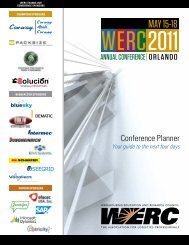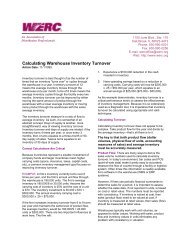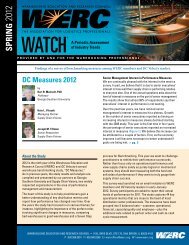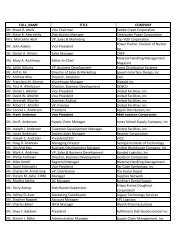Optimizing Inventory Management - WERC
Optimizing Inventory Management - WERC
Optimizing Inventory Management - WERC
You also want an ePaper? Increase the reach of your titles
YUMPU automatically turns print PDFs into web optimized ePapers that Google loves.
Green to go<br />
Just about everywhere you turn in the facility, you<br />
can find energy efficient design elements. To begin with,<br />
the company included an automated motion detecting<br />
lighting system throughout the DC. This keeps lights off<br />
in areas that are not being used, reducing energy consumption.<br />
The lights themselves are the newest T8<br />
efficient fluorescent lighting and are big energy savers.<br />
Because of this system, Jackson Family Wines was<br />
awarded a $200,000 rebate from local utility provider<br />
Pacific Gas and Electric. In all, the building’s energy<br />
savings are equivalent to the energy needed to power<br />
290 homes annually. “Our energy conservation translates<br />
to more than $250,000 a year in savings and electricity<br />
inflation has been six percent over the last 20 years,”<br />
says Boller.<br />
The LEED construction requirements meant that<br />
the site needed a storm water detention pond also. The<br />
system filters through a bio-swale and into a holding<br />
pond system. Overall, the site requires 40 percent less<br />
water than a traditional DC.<br />
Other features involving water usage include a<br />
non-chemical waste water treatment system. Instead of<br />
chemicals, the system treats water with ultraviolet light<br />
and electrical impulses, which eliminate bacterial<br />
growth.<br />
As to the building itself, the roof is made of a reflective<br />
white membrane that is designed to reduce heat<br />
absorption. This keeps the building temperature down,<br />
making employees more comfortable and productive, as<br />
well as helping the company maintain its product integrity.<br />
It also saves energy and keeps the company’s energy<br />
bills lower.<br />
The company also constructed the facility with the<br />
future in mind. The roof was upgraded to support the<br />
load of a one megawatt solar array. While not in use yet,<br />
should the company expand operations it is an option it<br />
can consider.<br />
Like many companies,<br />
Jackson Family Wines has<br />
learned that, while upfront<br />
costs might run higher<br />
to construct to LEED certification<br />
standards, the<br />
long-term savings make it<br />
all worthwhile. Operating<br />
expenses are much lower<br />
with such a green building<br />
and the ROI will come<br />
through those savings. In<br />
all, the construction bill<br />
came to about $28 million, which probably ran about 2<br />
percent higher than what a traditional build of the same<br />
size might have run. “We expect to have an ROI in less<br />
than two years,” Boller explains.<br />
Beyond the green benefits, the new DC has afforded<br />
Jackson Family Wines operational benefits too. “”We have<br />
faster order-to-ship times, decreased costs, and increased<br />
product quality through reduced handling,” Boller says.<br />
Customers and employees are thrilled with the<br />
results, says Boller. “It’s one of the nicest work spaces you<br />
could hope for, whether you’re in the DC or the offices.”<br />
For other companies contemplating changes for<br />
the greener, Boller offers this advice: “Start early and be<br />
persistent,” he says. “There’s a steep learning curve and<br />
once you get the hang of it, you have to keep pushing<br />
performance for each measure.”<br />
2010 © Copyright, <strong>WERC</strong>. All Rights reserved.<br />
“Our energy<br />
conservation translates<br />
to more than $250,000<br />
a year in savings and<br />
electricity inflation has<br />
been six percent over the<br />
last 20 years.”<br />
Robert Boller<br />
Good to go<br />
While the project went smoothly, Boller says that<br />
obtaining LEED certification isn’t always straightforward<br />
for this type of operation. “LEED is geared towards office<br />
buildings, not refrigerated warehouses,” he says, “so we<br />
missed out on a lot of points focused around employee’s<br />
work environment in an office setting.”<br />
/ September–October 2010 7







